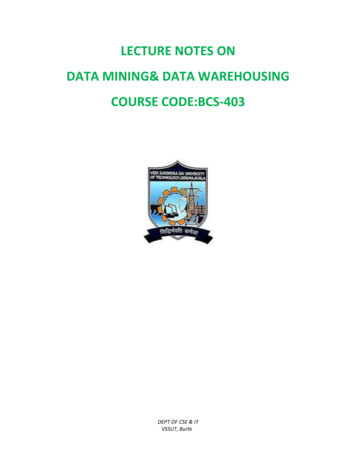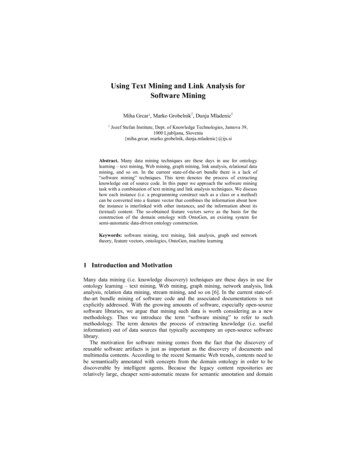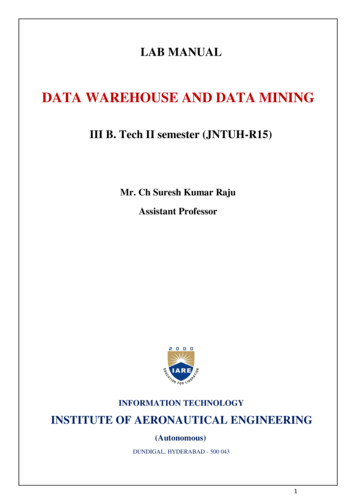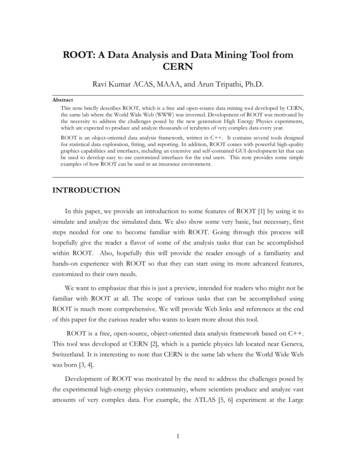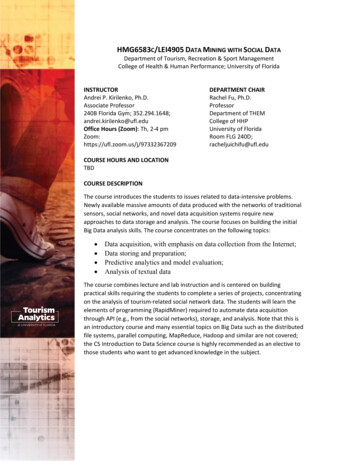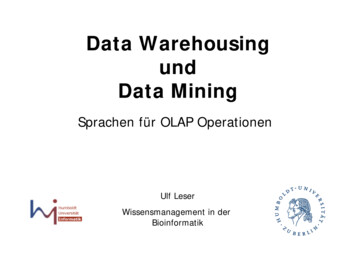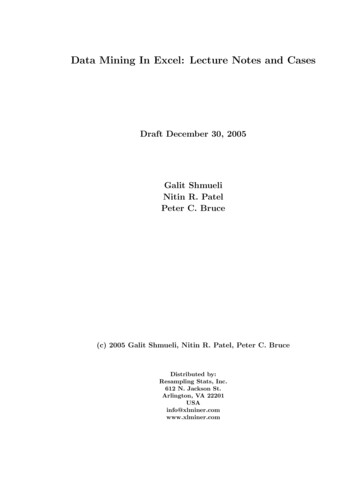
Transcription
Data Mining In Excel: Lecture Notes and CasesDraft December 30, 2005Galit ShmueliNitin R. PatelPeter C. Bruce(c) 2005 Galit Shmueli, Nitin R. Patel, Peter C. BruceDistributed by:Resampling Stats, Inc.612 N. Jackson St.Arlington, VA 22201USAinfo@xlminer.comwww.xlminer.com
2
Contents1 Introduction1.1 Who Is This Book For? . . . . . . . . . . .1.2 What Is Data Mining? . . . . . . . . . . . .1.3 Where Is Data Mining Used? . . . . . . . .1.4 The Origins of Data Mining . . . . . . . . .1.5 The Rapid Growth of Data Mining . . . . .1.6 Why are there so many different methods? .1.7 Terminology and Notation . . . . . . . . . .1.8 Road Maps to This Book . . . . . . . . . .1123345572 Overview of the Data Mining Process2.1 Introduction . . . . . . . . . . . . . . . . . . . . . . . . .2.2 Core Ideas in Data Mining . . . . . . . . . . . . . . . . .2.2.1 Classification . . . . . . . . . . . . . . . . . . . .2.2.2 Prediction . . . . . . . . . . . . . . . . . . . . . .2.2.3 Association Rules . . . . . . . . . . . . . . . . . .2.2.4 Predictive Analytics . . . . . . . . . . . . . . . .2.2.5 Data Reduction . . . . . . . . . . . . . . . . . . .2.2.6 Data Exploration . . . . . . . . . . . . . . . . . .2.2.7 Data Visualization . . . . . . . . . . . . . . . . .2.3 Supervised and Unsupervised Learning . . . . . . . . . .2.4 The Steps in Data Mining . . . . . . . . . . . . . . . . .2.5 Preliminary Steps . . . . . . . . . . . . . . . . . . . . .2.5.1 Organization of Datasets . . . . . . . . . . . . .2.5.2 Sampling from a Database . . . . . . . . . . . . .2.5.3 Oversampling Rare Events . . . . . . . . . . . .2.5.4 Pre-processing and Cleaning the Data . . . . . .2.5.5 Use and Creation of Partitions . . . . . . . . . .2.6 Building a Model - An Example with Linear Regression2.7 Using Excel For Data Mining . . . . . . . . . . . . . . .2.8 Exercises . . . . . . . . . . . . . . . . . . . . . . . . . .99999101010101011111212131313182027303 Data Exploration and Dimension Reduction3.1 Introduction . . . . . . . . . . . . . . . . . . . . . . . . . . .3.2 Practical Considerations . . . . . . . . . . . . . . . . . . . .3.3 Data Summaries . . . . . . . . . . . . . . . . . . . . . . . .3.4 Data Visualization . . . . . . . . . . . . . . . . . . . . . . .3.5 Correlation Analysis . . . . . . . . . . . . . . . . . . . . . .3.6 Reducing the Number of Categories in Categorical Variables.33333334363839i.
iiCONTENTS3.7.393943444647.49494949525559626768705 Multiple Linear Regression5.1 Introduction . . . . . . . . . . . . . . . . . . . . . . . . . . . . . . . . . . . .5.2 Explanatory Vs. Predictive Modeling . . . . . . . . . . . . . . . . . . . . . .5.3 Estimating the Regression Equation and Prediction . . . . . . . . . . . . . .5.3.1 Example: Predicting the Price of Used Toyota Corolla Automobiles5.4 Variable Selection in Linear Regression . . . . . . . . . . . . . . . . . . . . .5.4.1 Reducing the Number of Predictors . . . . . . . . . . . . . . . . . .5.4.2 How to Reduce the Number of Predictors . . . . . . . . . . . . . . .5.5 Exercises . . . . . . . . . . . . . . . . . . . . . . . . . . . . . . . . . . . . .7373737475787879836 Three Simple Classification Methods6.1 Introduction . . . . . . . . . . . . . . . . . . . . . . . . . . . . . . . . . . .6.1.1 Example 1: Predicting Fraudulent Financial Reporting . . . . . . .6.1.2 Example 2: Predicting Delayed Flights . . . . . . . . . . . . . . . .6.2 The Naive Rule . . . . . . . . . . . . . . . . . . . . . . . . . . . . . . . . .6.3 Naive Bayes . . . . . . . . . . . . . . . . . . . . . . . . . . . . . . . . . . .6.3.1 Bayes Theorem . . . . . . . . . . . . . . . . . . . . . . . . . . . . .6.3.2 A Practical Difficulty and a Solution: From Bayes to Naive Bayes6.3.3 Advantages and Shortcomings of the Naive Bayes Classifier . . . .6.4 k-Nearest Neighbor (k-NN) . . . . . . . . . . . . . . . . . . . . . . . . . .6.4.1 Example 3: Riding Mowers . . . . . . . . . . . . . . . . . . . . . .6.4.2 Choosing k . . . . . . . . . . . . . . . . . . . . . . . . . . . . . . .6.4.3 k-NN for a Quantitative Response . . . . . . . . . . . . . . . . . .6.4.4 Advantages and Shortcomings of k-NN Algorithms . . . . . . . . .6.5 Exercises . . . . . . . . . . . . . . . . . . . . . . . . . . . . . . . . . . . .87. 87. 87. 88. 88. 89. 89. 90. 94. 97. 98. 99. 100. 100. 1027 Classification and Regression Trees7.1 Introduction . . . . . . . . . . . . . . . . . . . . . .7.2 Classification Trees . . . . . . . . . . . . . . . . . .7.3 Recursive Partitioning . . . . . . . . . . . . . . . .7.4 Example 1: Riding Mowers . . . . . . . . . . . . .7.4.1 Measures of Impurity . . . . . . . . . . . .7.5 Evaluating the Performance of a Classification Tree.3.8Principal Components Analysis . . . . . . . . . . . . . . . . . . . . .3.7.1 Example 2: Breakfast Cereals . . . . . . . . . . . . . . . . . .3.7.2 The Principal Components . . . . . . . . . . . . . . . . . . .3.7.3 Normalizing the Data . . . . . . . . . . . . . . . . . . . . . .3.7.4 Using Principal Components for Classification and PredictionExercises . . . . . . . . . . . . . . . . . . . . . . . . . . . . . . . . .4 Evaluating Classification and Predictive Performance4.1 Introduction . . . . . . . . . . . . . . . . . . . . . . . . .4.2 Judging Classification Performance . . . . . . . . . . . .4.2.1 Accuracy Measures . . . . . . . . . . . . . . . . .4.2.2 Cutoff For Classification . . . . . . . . . . . . . .4.2.3 Performance in Unequal Importance of Classes .4.2.4 Asymmetric Misclassification Costs . . . . . . . .4.2.5 Oversampling and Asymmetric Costs . . . . . . .4.2.6 Classification Using a Triage Strategy . . . . . .4.3 Evaluating Predictive Performance . . . . . . . . . . . .4.4 Exercises . . . . . . . . . . . . . . . . . . . . . . . . . .105105105105106108113
CONTENTSiii7.5.1 Example 2: Acceptance of Personal LoanAvoiding Overfitting . . . . . . . . . . . . . . . .7.6.1 Stopping Tree Growth: CHAID . . . . . .7.6.2 Pruning the Tree . . . . . . . . . . . . . .7.7 Classification Rules from Trees . . . . . . . . . .7.8 Regression Trees . . . . . . . . . . . . . . . . . .7.8.1 Prediction . . . . . . . . . . . . . . . . . .7.8.2 Measuring Impurity . . . . . . . . . . . .7.8.3 Evaluating Performance . . . . . . . . . .7.9 Advantages, Weaknesses, and Extensions . . . . .7.10 Exercises . . . . . . . . . . . . . . . . . . . . . .1131141171171221221221251251251278 Logistic Regression8.1 Introduction . . . . . . . . . . . . . . . . . . . . . . . . . . . . . . . . . . . . . . . . .8.2 The Logistic Regression Model . . . . . . . . . . . . . . . . . . . . . . . . . . . . . .8.2.1 Example: Acceptance of Personal Loan . . . . . . . . . . . . . . . . . . . . .8.2.2 A Model with a Single Predictor . . . . . . . . . . . . . . . . . . . . . . . . .8.2.3 Estimating the Logistic Model From Data: Computing Parameter Estimates8.2.4 Interpreting Results in Terms of Odds . . . . . . . . . . . . . . . . . . . . . .8.3 Why Linear Regression is Inappropriate for a Categorical Response . . . . . . . . . .8.4 Evaluating Classification Performance . . . . . . . . . . . . . . . . . . . . . . . . . .8.4.1 Variable Selection . . . . . . . . . . . . . . . . . . . . . . . . . . . . . . . . .8.5 Evaluating Goodness-of-Fit . . . . . . . . . . . . . . . . . . . . . . . . . . . . . . . .8.6 Example of Complete Analysis: Predicting Delayed Flights . . . . . . . . . . . . . .8.7 Logistic Regression for More than 2 Classes . . . . . . . . . . . . . . . . . . . . . . .8.7.1 Ordinal Classes . . . . . . . . . . . . . . . . . . . . . . . . . . . . . . . . . . .8.7.2 Nominal Classes . . . . . . . . . . . . . . . . . . . . . . . . . . . . . . . . . .8.8 Exercises . . . . . . . . . . . . . . . . . . . . . . . . . . . . . . . . . . . . . . . . . .1311311321331351371391401401431431451531531541559 Neural Nets9.1 Introduction . . . . . . . . . . . . . . . . . . . . . . . . . . . .9.2 Concept and Structure of a Neural Network . . . . . . . . . .9.3 Fitting a Network to Data . . . . . . . . . . . . . . . . . . . .9.3.1 Example 1: Tiny Dataset . . . . . . . . . . . . . . . .9.3.2 Computing Output of Nodes . . . . . . . . . . . . . .9.3.3 Preprocessing the Data . . . . . . . . . . . . . . . . .9.3.4 Training the Model . . . . . . . . . . . . . . . . . . . .9.3.5 Example 2: Classifying Accident Severity . . . . . . .9.3.6 Using the Output for Prediction and Classification . .9.4 Required User Input . . . . . . . . . . . . . . . . . . . . . . .9.5 Exploring the Relationship Between Predictors and Response9.6 Advantages and Weaknesses of Neural Networks . . . . . . .9.7 Exercises . . . . . . . . . . . . . . . . . . . . . . . . . . . . .15915915916016016116316416716917317417417510 Discriminant Analysis10.1 Introduction . . . . . . . . . . . . . . . . .10.2 Example 1: Riding Mowers . . . . . . . .10.3 Example 2: Personal Loan Acceptance . .10.4 Distance of an Observation from a Class .10.5 Fisher’s Linear Classification Functions .10.6 Classification Performance of Discriminant.1771771771771781801847.6. . . . . . . . . . . . . . . . . . . . . . . . . .Analysis.
ivCONTENTS10.7 Prior Probabilities . . . . . . . . . .10.8 Unequal Misclassification Costs . . .10.9 Classifying More Than Two Classes10.9.1 Example 3: Medical Dispatch10.10Advantages and Weaknesses . . . . .10.11Exercises . . . . . . . . . . . . . . . . . . . . . . . . . . . . . . . . . . . . . . . . . . . . .to Accident Scenes. . . . . . . . . . . . . . . . . . . . .18518518618618819011 Association Rules11.1 Introduction . . . . . . . . . . . . . . . . . . . . . . . . . . . .11.2 Discovering Association Rules in Transaction Databases . . .11.3 Example 1: Synthetic Data on Purchases of Phone Faceplates11.4 Generating Candidate Rules . . . . . . . . . . . . . . . . . . .11.4.1 The Apriori Algorithm . . . . . . . . . . . . . . . . . .11.5 Selecting Strong Rules . . . . . . . . . . . . . . . . . . . . . .11.5.1 Support and Confidence . . . . . . . . . . . . . . . . .11.5.2 Lift Ratio . . . . . . . . . . . . . . . . . . . . . . . . .11.5.3 Data Format . . . . . . . . . . . . . . . . . . . . . . .11.5.4 The Process of Rule Selection . . . . . . . . . . . . . .11.5.5 Interpreting the Results . . . . . . . . . . . . . . . . .11.5.6 Statistical Significance of Rules . . . . . . . . . . . . .11.6 Example 2: Rules for Similar Book Purchases . . . . . . . . .11.7 Summary . . . . . . . . . . . . . . . . . . . . . . . . . . . . .11.8 Exercises . . . . . . . . . . . . . . . . . . . . . . . . . . . . 2 Cluster Analysis12.1 Introduction . . . . . . . . . . . . . . . . . . . . . . . . .12.2 Example: Public Utilities . . . . . . . . . . . . . . . . .12.3 Measuring Distance Between Two Records . . . . . . . .12.3.1 Euclidean Distance . . . . . . . . . . . . . . . . .12.3.2 Normalizing Numerical Measurements . . . . . .12.3.3 Other Distance Measures for Numerical Data . .12.3.4 Distance Measures for Categorical Data . . . . .12.3.5 Distance Measures for Mixed Data . . . . . . . .12.4 Measuring Distance Between Two Clusters . . . . . . .12.5 Hierarchical (Agglomerative) Clustering . . . . . . . . .12.5.1 Minimum Distance (Single Linkage) . . . . . . .12.5.2 Maximum Distance (Complete Linkage) . . . . .12.5.3 Group Average (Average Linkage) . . . . . . . .12.5.4 Dendrograms: Displaying Clustering Process and12.5.5 Validating Clusters . . . . . . . . . . . . . . . . .12.5.6 Limitations of Hierarchical Clustering . . . . . .12.6 Non-Hierarchical Clustering: The k-Means Algorithm .12.6.1 Initial Partition Into k Clusters . . . . . . . . . .12.7 Exercises . . . . . . . . . . . . . . . . . . . . . . . . . . . . . . . . . . . . . . . . . . . . . . . . . . . . . . . . . . . . . . . . . . . . . . . . . . . . . .Results. . . . . . . . . . . . . . . . . . . . 2022122222513 Cases13.1 Charles Book Club . . . . . . . . . .13.2 German Cred
XLMiner is a comprehensive data mining add-in for Excel, which is easy to learn for users of Excel. It is a tool to help you get quickly started on data mining
